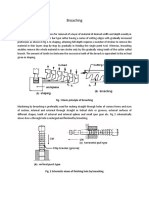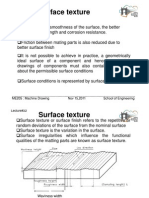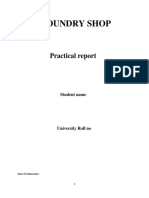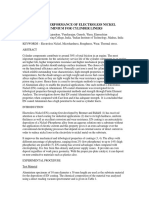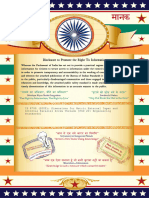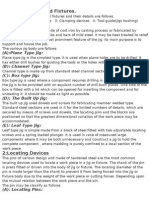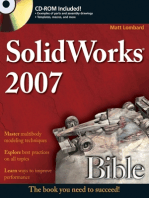Sheet Metal Working
Sheet Metal Working
Uploaded by
Bhupendhar HarshawardanCopyright:
Available Formats
Sheet Metal Working
Sheet Metal Working
Uploaded by
Bhupendhar HarshawardanCopyright
Available Formats
Share this document
Did you find this document useful?
Is this content inappropriate?
Copyright:
Available Formats
Sheet Metal Working
Sheet Metal Working
Uploaded by
Bhupendhar HarshawardanCopyright:
Available Formats
SHEET METAL WORKING
1. Introduction Sheet metal is simply metal formed into thin and flat pieces. It is one of the fundamental forms used in metalworking, and can be cut and bent into a variety of different shapes. Countless everyday objects are constructed of the material. Thicknesses can vary significantly, although extremely thin thicknesses are considered foil or leaf, and pieces thicker than 6 mm (0.25 in) are considered plate. 2. Sheet metal processing The raw material for sheet metal manufacturing processes is the output of the rolling process. Typically, sheets of metal are sold as flat, rectangular sheets of standard size. If the sheets are thin and very long, they may be in the form of rolls. Therefore the first step in any sheet metal process is to cut the correct shape and sized blank from larger sheet. 3. Sheet metal forming processes Sheet metal processes can be broken down into two major classifications and one minor classification 1. 2. 3. 4. 5. Shearing processes -- processes which apply shearing forces to cut, fracture, or separate the Forming processes -- processes which cause the metal to undergo desired shape changes Finishing processes -- processes which are used to improve the final surface characteristics. Punching: shearing process using a die and punch where the interior portion of the sheared Blanking: shearing process using a die and punch where the exterior portion of the material. without failure, excessive thinning, or cracking. This includes bending and stretching. 3.1 Shearing Process sheet is to be discarded. shearing operation is to be discarded. Perforating: punching a number of holes in a sheet Parting: shearing the sheet into two or more pieces Notching: removing pieces from the edges
6.
Lancing: leaving a tab without removing any material
Fig.1Shearing Operations: Punching, Blanking and Perforating 3.2 Forming Processes Bending: forming process causes the sheet metal to undergo the desired shape change by Stretching: forming process causes the sheet metal to undergo the desired shape change by Drawing: forming process causes the sheet metal to undergo the desired shape change by Roll forming: Roll forming is a process by which a metal strip is progressively bent as it bending without failure. Ref fig.2 & 2a stretching without failure. Ref fig.3 drawing without failure. Ref fig.4 passes through a series of forming rolls. Ref fig.5
Fig.2 Common Die-Bending Operations
Fig.2a
Various Bending Operations
Fig.3 Schematic illustration of a stretch-forming process.
Fig.4 Schematic of the Drawing process.
Fig.5 Eight-roll sequence for the roll forming of a box channel 3.3 Finishing processes Material properties, geometry of the starting material, and the geometry of the desired final product play important roles in determining the best process 4. Equipments Basic sheet forming operations involve a press, punch, or ram and a set of dies
4.1 Presses Mechanical Press - The ram is actuated using a flywheel. Stroke motion is not uniform. Ref fig.6 Hydraulic Press - Longer strokes than mechanical presses, and develop full force throughout the stroke. Stroke motion is of uniform speed, especially adapted to deep drawing operations. Ref fig.7
Fig.6 Mechanical Press
Fig.7 Hydraulic Press 4.2 Dies and Punches Simple- single operation with a single stroke Compound- two operations with a single stroke Combination- two operations at two stations Progressive- two or more operations at two or more stations with each press stroke, creates what is called a strip development
Fig 8 Progressive dies Punches 5. Tools and Accessories The various operations such as cutting, shearing, bending, folding etc. are performed by these tools. 5.1 Marking and measuring tools Steel Rule - It is used to set out dimensions. Try Square - Try square is used for making and testing angles of 90degree Scriber It used to scribe or mark lines on metal work pieces. Divider - This is used for marking circles, arcs, laying out perpendicular lines, bisecting lines, etc
Fig.9 Marking and measuring tools 5.2 Cutting Tools Straight snip - They have straight jaws and used for straight line cutting. Ref fig.10 Curved snip - They have curved blades for making circular cuts. Ref fig.10a
Ref fig.10 Straight snip
Ref Fig.10a Curved Snip 6. Striking Tools Mallet - It is wooden-headed hammer of round or rectangular cross section. The striking face is made flat to the work. A mallet is used to give light blows to the Sheet metal in bending and finishing. Ref fig.11
Fig.11 Types of Mallets 6. Merits 7. Demerits Wrinkling and tearing are typical limits to drawing operations Different techniques can be used to overcome these limitations o Draw beads o Vertical projections and matching grooves in the die and blank holder Trimming may be used to reach final dimensions Roofings Ductings High strength Good dimensional accuracy and surface finish Relatively low cost
8. Applications
9. Part A
Vehicles body buildings like 3 wheelers, 4 wheelers, ships, aircrafts etc. Furnitures, House hold articles and Railway equipment
Questions: 1. What is sheet metal work? 2. Write down any four sheet metal characteristics 3. What is meant by clearance? 4. What is stretching? 5. Define the term spring back 6. How force exerted on the form block is calculated 7. What are the formability test methods? 8. What is super plasticity of metals? 9. What is metal spinning process? 10. What is sheet metal?
Part B 11. What are Punching, Nibbling, Blanking, Piercing, tools/machines are needed for these processes? 12. What is deep drawing? Provide a few examples of products/parts made using deep drawing operations. 13. What is progressive die stamping? 14. Describe shearing operations in a sheet metal work with a neat sketch 15. Describe various types of bending operations with its neat sketches 16. Explain any one method of stretch forming operation with a neat sketch 17. Explain hydro forming process with its neat sketches. State their advantage and applications 18. Explain the power spinning process with a neat sketch .give their applications 19. How magnetic pulse forming process is carried out on sheet metal?Explain peen forming process with a neat sketch 20. What is super plastic of metal? How this process is carried out on sheet metals? END
11. References Book Manufacturing Technology by Hajra choudry Sheet metal working by Robert cook www.efunda.com www.esnips.com
Website
You might also like
- Diamond and CBN WheelsDocument22 pagesDiamond and CBN WheelsM. Aguiar100% (1)
- JigDocument6 pagesJigArun ManoNo ratings yet
- Unit 4 Sheet Metal ProcessDocument65 pagesUnit 4 Sheet Metal ProcessMANOJ MNo ratings yet
- Jigs and FixturesDocument4 pagesJigs and FixturesjoshivishwanathNo ratings yet
- Optimization of Grinding Cycle Time For End Mill ManufacturingDocument5 pagesOptimization of Grinding Cycle Time For End Mill ManufacturingIJARMATE100% (1)
- Types of JigDocument27 pagesTypes of JigRushabh SapariaNo ratings yet
- Mass, Volume & Density: 8 Grade PhysicsDocument19 pagesMass, Volume & Density: 8 Grade PhysicsHaniNo ratings yet
- Design & Manufacturing of Components of Modified Bench Vise On Rapid Prototype MachineDocument13 pagesDesign & Manufacturing of Components of Modified Bench Vise On Rapid Prototype MachineInternational Journal of Application or Innovation in Engineering & Management100% (1)
- Machine ToolspindleunitsDocument22 pagesMachine Toolspindleunitsdevmecz2696No ratings yet
- Knuckle Joints DesignDocument10 pagesKnuckle Joints DesignKvrd Prasad100% (1)
- CC 9221 Design For ManufactureDocument2 pagesCC 9221 Design For ManufactureM.Saravana Kumar..M.ENo ratings yet
- Broaching: Fig. 1 Basic Principle of BroachingDocument14 pagesBroaching: Fig. 1 Basic Principle of BroachingSiddharthNo ratings yet
- Material ProcessingDocument8 pagesMaterial ProcessingioanapanaitNo ratings yet
- 2nd ReviewDocument29 pages2nd ReviewretechNo ratings yet
- Sheet Metal FormingDocument9 pagesSheet Metal FormingKhin Aung ShweNo ratings yet
- Material Properties That Affect Sheet Metal FormabilityDocument24 pagesMaterial Properties That Affect Sheet Metal FormabilityNhan LeNo ratings yet
- Design and Analysis of PROTECTED FLANGE COUPLING Solidworks 2016 and ANSYS WorkbenchDocument27 pagesDesign and Analysis of PROTECTED FLANGE COUPLING Solidworks 2016 and ANSYS Workbenchamu100% (1)
- Marking ToolsDocument14 pagesMarking ToolsFabian NdegeNo ratings yet
- RollingDocument22 pagesRollingSahil JhambNo ratings yet
- Tomorrow's Materials TodayDocument2 pagesTomorrow's Materials TodayShantanu SinghaNo ratings yet
- Durability Assessments of Motorcycle Handlebars Ken-Yuan Lin, 2005 XXXXXDocument25 pagesDurability Assessments of Motorcycle Handlebars Ken-Yuan Lin, 2005 XXXXXjaydeepnaruleNo ratings yet
- Different Shaper Machine Accessories and AttachementsDocument3 pagesDifferent Shaper Machine Accessories and AttachementsJaymark BebatNo ratings yet
- 10 - Fundamentals of Metal Forming (Chapter 14)Document37 pages10 - Fundamentals of Metal Forming (Chapter 14)Taher al suhamiNo ratings yet
- Measuring InstrumentsDocument10 pagesMeasuring Instrumentsmohsin931No ratings yet
- Gears: Drawing Gear Teeth Spur GearsDocument16 pagesGears: Drawing Gear Teeth Spur GearsGvgfhjNo ratings yet
- Mech Engg Syllabus Modified (R10) 11.3.2012Document57 pagesMech Engg Syllabus Modified (R10) 11.3.2012Srimanthula SrikanthNo ratings yet
- Rivet and Riveted JointsDocument20 pagesRivet and Riveted Jointsdeepbhagat100% (1)
- Design and Analysis of Press Tool For Bracket Ijariie8756Document10 pagesDesign and Analysis of Press Tool For Bracket Ijariie8756Vineela ChNo ratings yet
- Lect22 Surface RoughnessDocument16 pagesLect22 Surface RoughnessAnshul SharmaNo ratings yet
- Foundary WorkshopDocument37 pagesFoundary WorkshopAsmitaNo ratings yet
- Cutting Force Measurements: S.DineshDocument20 pagesCutting Force Measurements: S.DineshMukesh Muraleedharan NairNo ratings yet
- Technical Plan For Roll Forming Machine: Model: WLFM40-250-1000Document5 pagesTechnical Plan For Roll Forming Machine: Model: WLFM40-250-1000ibrahimadiop1No ratings yet
- Mechanics of Metal CuttingDocument24 pagesMechanics of Metal CuttingSreehari ViswanathanNo ratings yet
- 2021 Metal Cutting, Metrology, Forming, Automation, Rootics by S K Mondal PDFDocument276 pages2021 Metal Cutting, Metrology, Forming, Automation, Rootics by S K Mondal PDFRitesh MishraNo ratings yet
- Final Edr ReportDocument10 pagesFinal Edr ReportNitin KharetaNo ratings yet
- Knuckle Joint Stress AnalysisDocument22 pagesKnuckle Joint Stress AnalysisAshutosh girdharNo ratings yet
- Colour Coding of Patterns: Patterns Are Imparted Certain Colours and Shades in Order ToDocument1 pageColour Coding of Patterns: Patterns Are Imparted Certain Colours and Shades in Order ToAppu MukundanNo ratings yet
- Design of Machine ElementsDocument32 pagesDesign of Machine ElementsNeerav SaxenaNo ratings yet
- G 10 - MOD 5 (File Used in Workshop)Document18 pagesG 10 - MOD 5 (File Used in Workshop)Deepak Kumar Kant KesriNo ratings yet
- Study On The Performance of Electroless Nickel Coating On Aluminium For Cylinder LinersDocument8 pagesStudy On The Performance of Electroless Nickel Coating On Aluminium For Cylinder LinersBharat Vinjamuri100% (1)
- Nomenclature of Face and End Milling CutterDocument4 pagesNomenclature of Face and End Milling CutterIsmael Aibis100% (1)
- Is.8788.2002 Metric Taper ThreadDocument16 pagesIs.8788.2002 Metric Taper ThreadGANESH GNo ratings yet
- Elements of Jigs and FixturesDocument9 pagesElements of Jigs and FixtureskhuljascribdNo ratings yet
- ME411-Workholding Device - 10.4.21Document71 pagesME411-Workholding Device - 10.4.21Albert VillarosaNo ratings yet
- CatalogueW180 PDFDocument46 pagesCatalogueW180 PDFSam NahuatlNo ratings yet
- Design of Fixtures For Automated Manufacturing SystemsDocument13 pagesDesign of Fixtures For Automated Manufacturing SystemsFagbohunmi GriffinNo ratings yet
- Production Technology (IV Sem)Document24 pagesProduction Technology (IV Sem)Shubham AgrawalNo ratings yet
- 2.design For SustainabilityDocument3 pages2.design For SustainabilitySenthil KumarNo ratings yet
- Name of The Experiment:: Study and Operation Bench Drilling MachineDocument5 pagesName of The Experiment:: Study and Operation Bench Drilling MachinemadNo ratings yet
- Honing Machine Actuated by ServomotorDocument45 pagesHoning Machine Actuated by ServomotorNissan PatelNo ratings yet
- Module-2 PPT PLCMDocument21 pagesModule-2 PPT PLCMSunil Kumar M100% (1)
- Die Design ParametersDocument3 pagesDie Design ParameterspunkhunkNo ratings yet
- Sheet MATALDocument9 pagesSheet MATALSunil KumarNo ratings yet
- Sheet Metal FormingDocument38 pagesSheet Metal FormingPriya ChilukuriNo ratings yet
- SBP Sheet Metal Working 1Document39 pagesSBP Sheet Metal Working 1Preet DamaniNo ratings yet
- Design Study of Progressive Tool DesignDocument34 pagesDesign Study of Progressive Tool Designsudheer9289% (9)













